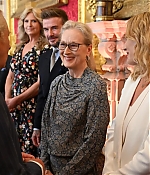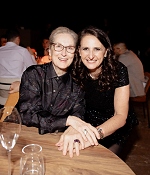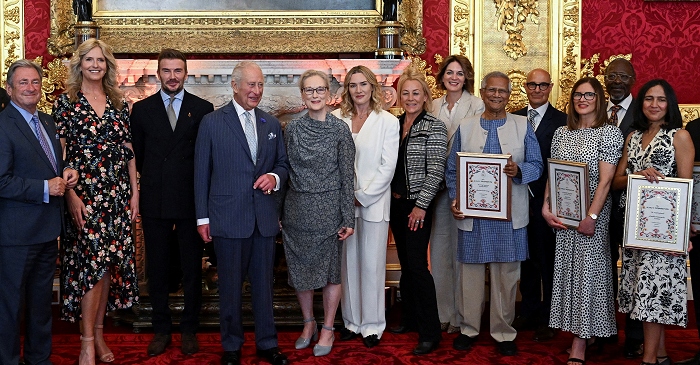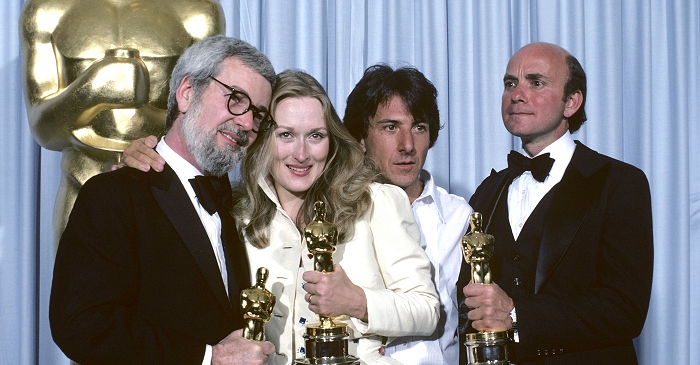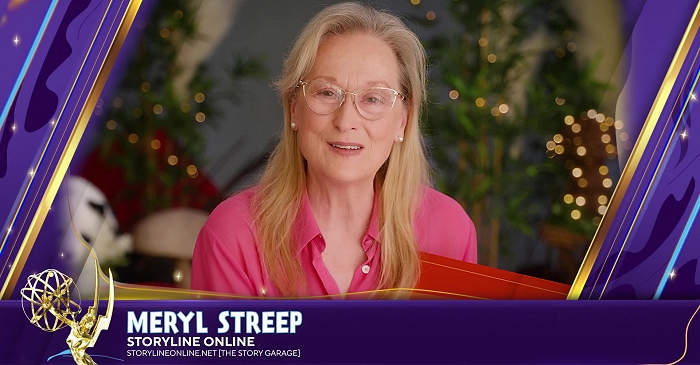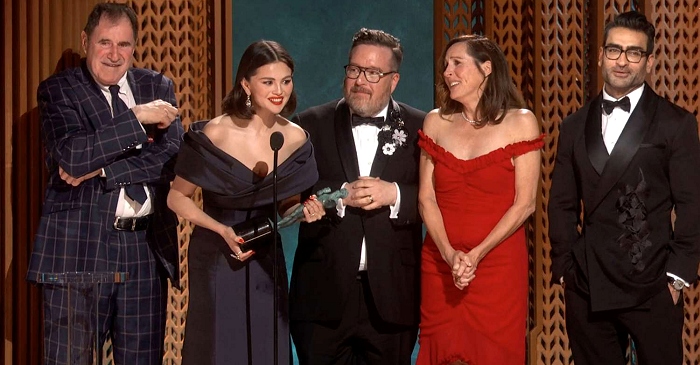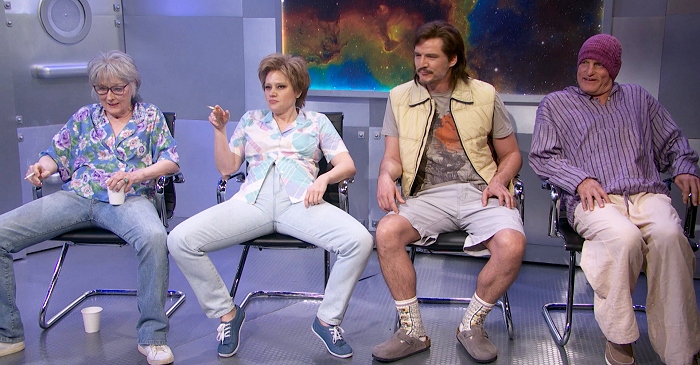|
Simply Streep is your premiere online resource on Meryl Streep's work on film, television and in the theatre - a career that has won her acclaim to be one of the world's greatest living actresses, winning three Academy Awards for "Kramer vs. Kramer", "Sophie's Choice" and "The Iron Lady". Created in 1999, Simply Streep has built an extensive collection over the past 25 years to discover Miss Streep's body of work through thousands of photographs, articles and video clips. Enjoy your stay and check back soon.
|
|
Meryl Streep: Her peculiar career
The New York Times ·
September 18, 1994
· Written by Bernard Weinraub
|
Meryl Streep is sitting in a hotel suite in New York, slowly picking at a fruit salad. She looks like a hip, scrubbed, well-to-do farm girl, far younger than 45. Her blonde hair is knotted in two shoulder-length pigtails; she’s wearing a loose, casually sleek dark green dress. Her fingers toy with the stone and glass necklace around her throat.Streep is distant but friendly and, at 5 foot 6, surprisingly slight. While not glamorous, she is quite beautiful. She hates interviews. “I hate seeing myself pontificating,” she says flatly. “I can’t bear it, as if I’m an expert on anything. I’m barely in control of my own life. And there’s the pressure to be articulate. With motherhood, you can barely put the subject before the predicate and make a sentence.”
The most acclaimed actress of her generation also hates re-examining a 20-year career that began with Shakespeare, flourished with William Styron and has, most recently, veered toward Robert James Waller, the author of the coy and overripe best seller “The Bridges of Madison County,” the movie version of which Streep began filming last week. In the last decade, the actress once called the female equivalent of Laurence Olivier has moved from critical successes to box office disappointments. “Bridges” is a financial coup, but it’s an unusual choice for the star of “Sophie’s Choice,” one Streep probably would not have made 10 years ago. But then, surviving as a movie actress at the age of 45 is nothing less than Darwinian.”You play the cards you’re dealt,” she says. “I’ve done the parts that have marched into my living room. I’ve asked Bill Styron to write another ‘Sophie’s Choice,’ but he hasn’t. And I can’t play Nat Turner. You know we all sort of pick what’s in season, what’s right at the time.”It’s not as if there’s a pathway of choices and you’re devising a game plan through them,” she continues. “Every actress will tell you they have maybe two things per year that they can possibly stand to put themselves into.”In the past year, Streep put herself into “House of the Spirits,” which came and went quickly last spring, and “The River Wild,” which opens on Sept. 30. A big-budget action-adventure movie with a feminist slant, “The River Wild” is perhaps even a greater departure for Streep than “Bridges.” And even before it has opened, the film has revived Streep’s career, bathing her in the kind of glory Hollywood bestows with hefty receipts.
Because of the buzz on “The River Wild,” Streep’s pay has climbed substantially: she will receive $4 million to $5 million for “Bridges,” plus a percentage of the gross, putting her in the same league as younger stars like Geena Davis, Meg Ryan and Demi Moore.Demi Moore?”To use an overused word, but in her case it applies, Meryl is a genius,” says Alan J. Pakula, who directed Streep in her Academy Award-winning role in “Sophie’s Choice.” “She has a remarkable, God-given talent, combined with an absolutely first-rate intelligence. She has an acting range that’s as broad as she wants it to be. I sometimes wish Meryl had been English because she would have done so many great classical roles for which she has a gift more than any actress on earth.”To understand her initial and extraordinary impact on Hollywood, one must recall not only the moment Streep arrived – in the late 1970’s – but her lineage. She hit Hollywood when the reigning female stars were Goldie Hawn and Barbra Streisand, Sally Field and Cher. Streep had been trained at Yale and nurtured at the New York Shakespeare Festival. She outdistanced her contemporaries with roles (and accents) set against backdrops like the Holocaust, Africa in the 20’s and postwar England.She had a perfect East Coast pedigree, signaling quality and class. Streep grew up in Summit, N.J., the older sister to two brothers. Her father was an executive with Merck, the pharmaceutical company; her mother was a commercial artist.At Vassar, she majored in drama. After an audition at the Yale Drama School, in which she delivered lines from Portia in “The Merchant of Venice” and Blanche in “A Streetcar Named Desire,” Streep was given a three-year scholarship.
She was indeed a formidable talent, and her career was charmed. Days after arriving in New York in 1975, Streep began working at the New York Shakespeare Festival and the Phoenix Theater. By 1977, she had a small role in the film “Julia.” A year later, she received an Academy Award nomination for her role in “The Deer Hunter” and an Emmy for her performance in the NBC mini-series “Holocaust.”Streep didn’t hang out in Malibu. She lived in SoHo, the Upper East Side, Connecticut. She married a sculptor, Donald Gummer, and began raising a family.And Hollywood loved it. Loved her distance, her reclusiveness and, to some extent, her aloofness from the place. By 1979, Streep had appeared in three significant films. In “Manhattan,” she played a fierce (and funny) lesbian-feminist. In “The Seduction of Joe Tynan,” she was a sexy Southern civil rights lawyer. And in “Kramer vs Kramer,” she played a woman who leaves her husband and son to search for her identity.The parts that followed, like “The French Lieutenant’s Woman,” “Sophie’s Choice,” “Out of Africa,” “Plenty” and “Silkwood,” solidified Streep’s position not only as Hollywood’s pre-eminent actress, but its most chameleon-like.Pakula still recalls the first rehearsal of “Sophie’s Choice.” “Before we began to read, we were sitting around for an hour, doing the usual kibitzing,” he says. “She said the first line of dialogue, and it had nothing to do with the actress I’d been talking to. My reaction was shock. Somewhere along the line, she had created this woman inside of herself.”Robert Redford, her co-star in “Out of Africa,” says that “what she does is to convert the very difficult technical tasks – a Dutch accent, a Polish one, an Australian one – into a comfortability so you believe it. She has this extraordinary sense of truth.”In time, however, the gravity she brought to her work made her a threat, perhaps even an anachronism, in the movie business. There was an inevitable reaction. Lighten up, said the critics. Enough with the accents, said the industry. And Streep, eager to please, aware that her movies were not making money and acutely sensitive to criticism, tried to join the party.
Abpruptly, she changed the kind of movies she made.”Heartburn,” (1986) was a featherweight comedy based on Nora Ephron’s book of the same name. In “She-Devil” (1989), Streep co-starred with Roseanne Barr and played a ditzy romance novelist. In “Postcards From the Edge” (1990), she played an actress saddled with drugs, men and a show-business mother. “Defending Your Life” (1991) was a loopy Albert Brooks comedy about the afterlife of an ad man. “Death Becomes Her” (1992), in which she co-starred with Goldie Hawn, was the first plastic surgery comedy. Most of the films could best be described as rental fare, not “Meryl Streep” movies.”The one thing Meryl couldn’t do was the one thing she desperately wanted to do,” says one prominent director. “She had to prove she’s a great comedienne.”But the Carole Lombard approach didn’t work. The cumulative reaction – financial and critical – to these movies was quite damaging. She tried playing their game; it didn’t succeed. And then the aloofness disappeared and she got angry. Why, she asked, did male stars like Jack Nicholson earn millions more than female stars? For the first time in her career, she seemed publicly hurt, even petulant.
Perhaps the most volcanic change in Streep’s career took place in 1991, when she switched agents. An actor switching agents is not exactly big news, but Sam Cohn, the prominent New York-based agent at International Creative Management is not just any agent.What happened remains murky. Streep speaks hesitantly about it. According to several agents, the rift centered on casting Streep in “Remains of the Day.” Mike Nichols, whom she regarded as a trusted friend – he had directed her in “Heartburn” and “Postcards From the Edge”- planned to direct the movie. But after Streep and Jeremy Irons read for him, Nichols apparently decided they were unsuitable. He declined to tell Streep. So did Cohn, who was also Nichols’s agent. By all accounts, Streep wasn’t just outraged, she was deeply hurt. And she severed her relationship with Cohn, signing with the powerful Creative Artists Agency. Eventually, the team of Ruth Prawer Jhabvala, Ismail Merchant and James Ivory took over the film, casting Anthony Hopkins and Emma Thompson in the lead roles.”I left because of something Mike did that I felt Sam should have protected me from,” Streep says. She speaks cryptically and emotionally about the episode. “Mike knows what he did, but unfortunately Sam wore the scar.”Streep says she’s now friendly with both men. “My relationship with them is in the ‘life’s too short to be mad category,’ ” she says. “Mike is someone I share an enormous amount of history with. He has a big part of my heart. I was very upset to be upset. I have too much of a need for forgiveness in my life.”Nichols refuses to discuss Streep. Cohn says he prefers not to talk about the falling-out, but then remarks: “In the work I do, one is not privileged to work too often with artists like Meryl. She has complete technical mastery, she’s extremely intelligent, she has a broad education.”Hollywood partly blamed Cohn. Many said that Streep had been isolated on the East Coast to her disadvantage and had been treated somewhat like a princess in a tower.”That’s revolting!” Cohn exclaims. “I’m revolted by that! Meryl is an intelligent cosmopolitan person. She does not have to live on Rodeo Drive to be part of the film community.”Streep’s shift to C.A.A. coincided in 1991 with a move to Los Angeles, where she and her husband purchased a house in tony Brentwood, not too far from the scene of the murders in the O. J. Simpson case. The actress says she made the move because she was filming a number of movies in Los Angeles. But earlier this summer, Streep returned to Connecticut, and she insists that this was her intent in the first place.
“If my children went to high school on the West Coast, that’s where they’d go to college,” she says. “And I was afraid I’d be on the East Coast.”One prominent director says that Streep made a mistake moving to California. “You have to keep a distance from there,” he says. “You’ve got to stay aloof from the agents and lawyers and gossip. I honestly believe she was looking at career survival and saying to herself, ‘Maybe I should join the mainstream more, so I’ll listen to my agents.’ But she appeared in too much dumb stuff. She listened to voices other than her own.”
Now, Streep is back on the East Coast and she seems to have put much of her anger behind her. If Hollywood failed to nurture her as a great dramatic actress, if she couldn’t replicate Carole Lombard or Lucille Ball, Streep would do what others have done before her: make splashy big-budget films at the expense of riskier, more high-toned ones.There’s a certain poignancy about Streep’s third decade in the business, a decade in which she is making the trade-offs of the older star, trade-offs that have already increased her box office value at a time when her contemporaries are struggling for any decent role.Her career moves have less to do with choice than survival in the Hollywood marketplace. After all, Hollywood frightens and discards middle-aged actresses. Some give up and retire (Jane Fonda), some play “older” parts (Sally Field was Tom Hanks’s lover in “Punchline” in 1988 and is currently his mother in “Forrest Gump,”) or dowdy, grandmother roles (Shirley MacLaine). Kathleen Turner, once a sexy star, is now “Serial Mom.” And Jessica Lange isn’t working much.”I don’t have a game plan for any of it,” Streep says. “An actor is always dependent on what comes around. Certainly I am because I don’t have a production company. I have no interest or time for that. I have four kids and that’s a big development company right there. People sometimes look at my life and think this is all effortlessly done. All these kids and it all works so easily. It doesn’t. Not at all. There’s a lot of volcanic constant change involved with children and transitions.”Why in the past didn’t she seek big commercial roles like contemporaries Glenn Close (“Fatal Attraction”) or Sigourney Weaver (“Alien”)? The idea seems to appall her. “I never aimed for that,” she says. “It’s not part of the thing that makes you feel good. It buys you a house. It makes your value come up in studio discussions, I suppose. But I’ve never been interested. I just try to keep working in a varied kind of way, to exercise different parts of my acting thing.”I never aimed for the big hit,” she says, smiling. “I don’t have the machine to do that.” And then she laughs. ” I’m pretty aware of what I look like. I don ‘t look like Sharon Stone, and I’m not built like her.”For all her bravado, Streep is still edgy on the subject of her comedic choices. She’s not at all pleased with the suggestion that her role in “Death Becomes Her,” for example, wasn’t quite up to her talents.”I’m so sorry you think that,” she says tersely. “You know,” she continues, “everything I do is serious even, as you said, my lighter things. To me, they were very serious. I mean even the hyperbolic comedies like ‘Death Becomes Her.’ Sure, I don’t think anybody took it that way, but I liked what it was about.” (It was about women struggling to stay young via facial and body surgery).
But what about all those years squandered? Streep sighs, and smiles vaguely. “I don’t know how to respond to that.”Streep also shrugs off her past indictment of Hollywood’s agism, saying that Nicholson, a friend, complains about Hollywood’s treatment of older actors. “I ‘ve talked to him and he was saying -” she proceeds to give a good Nicholson imitation – ” ‘You women, you whine about this, you should see how many scripts there are for 60-year-old men.’ “”If I were supercompetitive, and if I really paid attention to this issue,” Streep continues, “I’d get more upset about it than I am. I know movies are a function of our dream world. And when you project yourself on screen, it’s easier to project yourself into what you were, not what you are. I still think of myself as 32, so it’s easy to project that on the screen. Most men think of themselves, you know, as in their middle 30’s even when they’re in their 40’s and 50’s.” She shakes her head. “Movies are a young person’s playground.”I’m aware that most movies are written for women in their 20’s and 30’s, and these are sort of dopey parts,” she says. “The ones in their 30’s get the richest and most interesting parts. And for women in their 40’s, it’s hit and miss.” She pauses and repeats the words: “Hit and miss.”
In “The River Wild”, Streep costars with Kevin Bacon and David Strathairn as a likable Boston mother in a troubled marriage who goes on an unexpectedly violent and treacherous white water rafting trip in the wilds of western Montana.The movie was directed by Curtis Hanson (“The Hand That Rocks the Cradle”), one of the more skilled directors in the business. The filming took place over four arduous months, on rivers near Libby and West Glacier, Mont., as well as Grants Pass, Ore. It is, of course, an entirely new Streep: physically tough, without an accent, without the clinical and sometimes remote acting technique criticized by Pauline Kael, the former New Yorker critic. Ms. Kael once wrote that Streep acted “only from the neck up” and that she was “pallid and rather glacial.” Streep says now, “It’s so awful that someone you admire hates what you do.””The elements of outdoor river adventure were so appealing,” she says. “And here was a woman in a sort of non-victim heroic part, a mother, someone I could relate to, who was really closer to me maybe than other things I’ve done. Besides, I couldn’t believe they wanted me for it. I thought they’d get somebody younger and stronger.”Her gamble in taking on an adventure film seems to have paid off. The buzz about her performance is strong. And studio executives and film makers are examining Streep’s skills in a different light: sure she’s a great actress, sure she does accents, but maybe she’ll open a movie now, maybe the audience will warm to her, maybe the hits will finally resume.In August, Clint Eastwood phoned Streep at home in Connecticut and offered her one of the most sought-after female movie roles in years, the part of Francesca Johnson, the lonely, Italian-born farm wife in the saccharine love story “The Bridges of Madison County.” Eastwood will co-star as her lover and direct the movie.
In accepting the role almost as soon as Eastwood phoned, Streep turned down a last-minute offer from Robert Redford to co-star with him in “Crisis in the Hot Zone,” about real-life scientists fighting a lethal virus. Redford dropped out of the project as soon as Streep did.Eastwood says that he cast Streep in “Bridges” even before he saw “The River Wild.” “For some reason, everybody early in the game thought that we should find a European gal for the part,” he says. “I just didn’t understand why. I felt they overlooked the potential of American actresses, and Meryl Streep is one of our most important.” Eastwood says Streep was the only actress offered the part. It probably didn’t hurt that the buzz was so strong on “The River Wild.”For her part, Streep says that while she didn’t care for the novel by Robert James Waller, the screenplay by Ron Bass and Richard LaGravenese was first-rate. Whatever the quality of the screenplay – and no matter, perhaps, that the book seems threadbare – Streep is certainly aware that accepting the prized role is a wise career move that could strengthen her appeal to mainstream audiences. Although she insists that her eyes glaze over when deals and contracts are discussed, one of her friends said that the actress is a shrewd businesswoman with the ambition of earning as much money as possible.
Following “Bridges,” Streep is set to start almost immediately on another high-profile project, “Before and After,” co-starring Liam Neeson. The film is based on the best seller by Rosellen Brown about a New England couple shattered by the news that their son had been arrested for murdering a girl. At this point, Streep is aware that the turbulence in her professional life may be over.”I emerged from ‘River Wild’ with a lot of metaphors for living,” she says. “Metaphors about taking risks, calculable risks, and being as strong as you can and then just sort of knowing it’s all up to fate anyway.”


